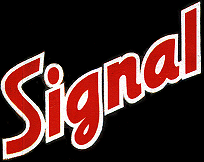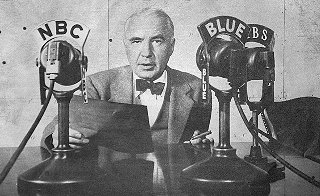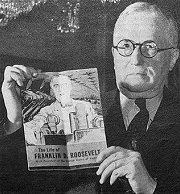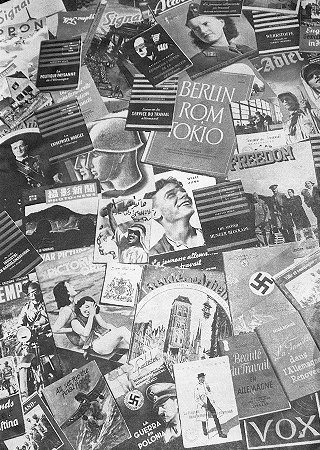
 | Signal. Sonderausgabe der |
|---|
[ Documents & Research ] → "U.S. Is Loosing the War of Words" – LIFE, 1943
This article is taken from the March 22, 1943 issue of LIFE. It spans pages 11-15 and is profusely illustrated. Selected images have been included in this reproduction.

Vol. 14, No. 12
March 22, 1943
U.S. IS LOSING THE WAR OF WORDS

ELMER DAVIS, SENATOR OF THE OFFICE OF WAR INFORMATION,
BROADCASTS THE FIRST OF A REGULAR WEEKLY SERIES OF WAR
ANALYSES FROM HIS DESK IN WASHINGTON
From all the battlefronts where Americans are fighting, the news was good last week. Our guns, tanks, ships, planes and troops were proving themselves superior to any equal numbers that the Axis could muster against them. But there was one theater of the war where Americans were still not big enough, sure enough or smart enough to challenge Axis superiority – the theater of political warfare or propaganda. Congressional critics, led by John Taber, Republican Representative from New York, were turning their attention to the Office of War Information, the U.S. equivalent of a Ministry of Propaganda. The immediate reason for the Congressional interest was a crudely drawn OWI picture booklet on the Life of Franklin D. Roosevelt, which Taber claimed was "a lot of cheap political propaganda."
But the question as to the intent or merit of this picture book, produced for foreign distribution, was insignificant compared to the broader problem: was the U.S. winning or losing the war of words?
Last week Elmer Davis, director of the Office of War Information, went back on the air to deliver the first of a series of weekly analyses of the war. In this talk Davis skipped political warfare, but told the radio audience that on the military battlefields of the worlds "our side is on the offensive, strategically." If he had tried, he could not have honestly painted such a reassuring picture of the propaganda battlefield. Nobody in Washington knew better than OWI Director Davis that he was still running a puny pushcart compared to the high-powered propaganda machine operated by the Nazis. The Overseas Branch of the OWI spends only $26,000,000 a year. Nazi Dr. Goebbels spends between $250,000,000 and $500,000,000 annually. The Chief U.S. foreign propaganda magazine Victory, over which a Congressional economy storm blew up last month, is but a pallid imitation of the German Signal. Victory has less than half the circulation of Signal, contains no terrific propaganda sock like its Nazi counterpart. The reason for this difference in wallop can be seen in the examples of U.S. (pp. 12-13) and Axis propaganda (pp. 14-15). The OWI sticks to facts, shuns exaggerations, tries to bring the peoples of the world messages about our leaders, our war aims, our growing armed might. The Axis harangues, scoffs, falsifies, attempts to divide.
 demanding investigation of the OWI, holds up a copy of the cartoon life of Roosevelt. |
The best propaganda is based on truth but it must be forceful, inventive, consistent. In the last war Allied propaganda was so effective that it broke down German morale. But in this war the U.S. lacks a clear-cut policy in the verbal ammunition it fires at peoples of Occupied Europe, in printed promises it drops to Germans or Italians or Japs. For example, from month to month neither our propagandists nor the Axis people who receive their propaganda know for sure what American policy will be when the U.S. has won the war. On one occasion the propaganda line is that the enemy will be destroyed, the next time that conquered peoples will be clothed and fed. |
U.S. PROPAGANDA
The OWI slowly sharpens its words
in the duel for people's beliefs
Although they are the world's masters of advertising and publicity, Americans as a people have always resented propaganda by government. Since it is now a necessary weapon of political warfare, the U.S., through the OWI, is slowly trying to master it. Their handicaps are shortages of training and funds, and the lack of a single credo, typical in a democratic nation. The Nazis have invariably employed "the strategy of terror" to invade the enemy's mind. Elmer Davis and the OWI have been trying to counteract this with "the strategy of truth." The results, some of which are reproduced on these pages, are not always as slashing or colorful as those of the Axis (pp. 14-15). But with typical Yankee ingenuity the OWI has added a few new propaganda wrinkles. American leaflets and pamphlets are dropped from the air over occupied areas, hidden in babies' diapers, printed on the inside of badly wanted matchboxes, or attached to a needle & thread.
War of Words (continued)
AXIS PROPAGANDA
Its lies are sent around the world
by a smooth, high-powered machine
Long before the war, Berlin, Rome and Tokyo perfected great, intricate and effective propaganda machines. Today the crafty men who cast the Axis line from Singapore to Valparaiso are far ahead of the U.S. They have talent, experience, almost unlimited funds and no compunctions about honesty. In 18 languages they spread their lies, fomenting hatred against the United Nations, scoffing at our war aims and our leaders. On these pages are examples of their work.
|
The deadliest weapon in the vast Axis propaganda arsenal is Signal (upper left, opposite), a German twice-a-month picture magazine patterned after LIFE. Each issue of 1,000,000 copies is translated into all major languages, distributed in 23 countries. Signal costs $2,500,000 a year. The Japs have at least eight periodicals and use every journalistic line, including "cheese-cake"[1]. Nine Italian magazines boast of the peaceful, prosperous and beautiful life in sunny Fascist Italy. [Right: full-size photo from page 15 of the article. Axis periodicals shown include: Signal issues 2/40 and 9/40; Der Adler issue 23/42, copies of Freude und Arbeit, Berlin • Rom • Tokio, Tempo, as well as other pamphlets and booklets.] Notes
|

|
| Return to top of page | Disclaimer | © 2002 – 2010, Alexander Zöller. |